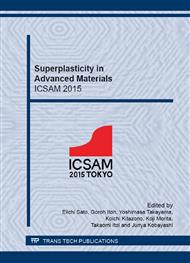[1]
M. Jackson, Superplastic Forming of Advanced Metallic Materials. Woodhead Publishing Limited, (2011).
Google Scholar
[2]
X. F. Xu, J. G. Zhang, C. F. Liu, G. C. Wang, and Z. H. Yun, Superplastic Behaviour and Microstructural Evolution in Stepped Tensile Deformation of Titanium Alloy, J. Mater. Eng. Perform., vol. 23, no. January, p.1–6, (2013).
DOI: 10.1007/s11665-013-0739-0
Google Scholar
[3]
J. -H. Cheng, The determination of material parameters from superplastic inflation tests, Journal of Materials Processing Technology, vol. 58, no. 2–3. p.233–246, (1996).
DOI: 10.1016/0924-0136(95)02128-0
Google Scholar
[4]
R. J. Lederich, S. M. L. Sastry, M. Hayase, and T. L. Mackay, Superplastic Formability Testing, JOM, vol. 34, no. 8, p.16–20, Dec. (2013).
DOI: 10.1007/bf03338067
Google Scholar
[5]
L. Carrino, G. Giuliano, and W. Polini, A method to characterise superplastic materials in comparison with alternative methods, J. Mater. Process. Technol., vol. 138, no. 1–3, p.417–422, (2003).
DOI: 10.1016/s0924-0136(03)00110-9
Google Scholar
[6]
A. El-Morsy, N. Akkus, K. Manabe, and H. Nishimura, Evaluation of Superplastic Material Characteristics Using Multi-Dome Forming Test, in Materials Science Forum, 2001, vol. 357–359, p.587–592.
DOI: 10.4028/www.scientific.net/msf.357-359.587
Google Scholar
[7]
D. Szeliga, J. Gawad, and M. Pietrzyk, Inverse analysis for identification of rheological and friction models in metal forming, Comput. Methods Appl. Mech. Eng., vol. 195, no. 48–49, p.6778–6798, (2006).
DOI: 10.1016/j.cma.2005.03.015
Google Scholar
[8]
J. Qu, Q. Jin, and B. Xu, Parameter identification of superplastic constitutive model by GA-based global optimization method, J. Mater. Process. Technol., vol. 197, no. 1–3, p.212–220, (2008).
DOI: 10.1016/j.jmatprotec.2007.06.011
Google Scholar
[9]
D. Sorgente and L. Tricarico, Characterization of a superplastic aluminium alloy ALNOVI-U through free inflation tests and inverse analysis, Int. J. Mater. Form., vol. 7, p.179–187, (2014).
DOI: 10.1007/s12289-012-1118-3
Google Scholar
[10]
D. Sorgente, G. Palumbo, and L. Tricarico, Material Superplastic Parameters Evaluation by a Jump Pressure Blow Forming Test, Key Eng. Mater., vol. 344, p.119–126, (2007).
DOI: 10.4028/www.scientific.net/kem.344.119
Google Scholar
[11]
H. S. Lee, J. H. Yoon, C. H. Park, Y. G. Ko, D. H. Shin, and C. S. Lee, A study on diffusion bonding of superplastic Ti-6Al-4V ELI grade, J. Mater. Process. Technol., vol. 187–188, p.526–529, (2007).
DOI: 10.1016/j.jmatprotec.2006.11.215
Google Scholar
[12]
F. U. Enikeev and a a Kruglov, AN ANALYSIS OF THE SUPERPLASTIC FORMING THIN CIRCULAR DIAPHRAGM, Int. J. Mech. Sci., vol. 37, no. 5, p.473–483, (1995).
DOI: 10.1016/0020-7403(94)00081-t
Google Scholar


